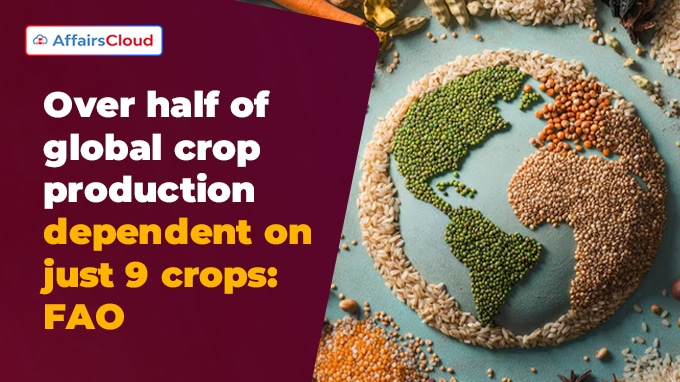 In March 2025, the United Nations Food and Agriculture Organization (UN FAO) based in Rome, Italy published the Third Report on the State of the World’s (SoW3) Plant Genetic Resources for Food and Agriculture (PGRFA), raising concerns about the declining diversity of plant genetic resources.
In March 2025, the United Nations Food and Agriculture Organization (UN FAO) based in Rome, Italy published the Third Report on the State of the World’s (SoW3) Plant Genetic Resources for Food and Agriculture (PGRFA), raising concerns about the declining diversity of plant genetic resources.
- The report was released on the 20th meeting of the Commission on Genetic Resources for Food and Agriculture (CGRFA-20) in Rome.
Note: PGRFA form the foundation of sustainable agrifood systems. These resources include the genetic diversity found in improved crop varieties, traditional farmer varieties, wild food plants, crop wild relatives, and breeding materials.
About SoW3PGFRA:
i.This report builds on the First and Second reports launched in 1996 and 2010 respectively and provides a comprehensive assessment of global conservation and sustainable use of PGRFA.
ii.The 2025 report, based on data from 128 countries and several research institutions, provides a detailed assessment of efforts to conserve and utilize PGRFA effectively. It also evaluates the human and institutional capacities required to support these initiatives.
Key Insights:
i.The report highlights key advancements, current gaps, and future challenges in managing PGRFA.
ii.The report states that despite the cultivation of around 6,000 plant species, the report revealed that 60% of global crop production depends on just nine crops, sugarcane, maize, rice, wheat, potatoes, soybeans, oil palm fruit, sugar beet, and cassava.
iii.The report highlights that traditional Farmer Varieties and Land Races (FV/LR) are under increasing threat. On average, 6% of FV/LR diversity worldwide is at risk, with some regions facing even greater losses.
- Southern Africa recorded the highest percentage of threatened diversity, followed by the Caribbean and Western Asia, while regions like Southern Asia, Australia, and New Zealand (NZ) had relatively lower levels of risk.
iv.Between 2011 and 2022, around 35 million hectares (Mha) in 51 countries, accounting for 44% of high-diversity crop areas, were cultivated with FV/LR. However, in-situ (on-farm) conservation remains a challenge, with 42% of surveyed plant taxa (classification of plant species) reported as threatened at either the species or varietal level.
v.The report emphasized that while progress has been made in ex situ (off-site) conservation over the past decade, significant challenges remain.
- The report pointed out that many countries lack proper assessments of how disasters affect agricultural biodiversity. Additionally, farmers receiving post-disaster seed distributions may struggle with unsuitable germplasm that is not well-adapted to their local environments.
Conservation Measures in India:
In India, conservation measures are essential to prevent large-scale genetic erosion. The report highlighted that over 50% of documented FV/LR across five agroecological zones are considered at risk.
i.One positive initiative noted was the Creation of Seed Hubs for Increasing Indigenous Production of Pulses project, launched in 2016 by the Ministry of Agriculture and Farmers Welfare (MoA&FW) .
ii.This initiative has significantly improved the availability of High-Yielding Varieties (HYVs) of pulse crops for smallholder farmers, contributing to a rise in pulse production from 14.76 million tonnes (Mt) in 2007–08 to 24.42 (Mt) in 2020–21.
About United Nations Food and Agriculture Organization (UN FAO) :
Director General (DG)– Qu Dongyu (China)
Headquarters– Rome, Italy
Established– 1945




